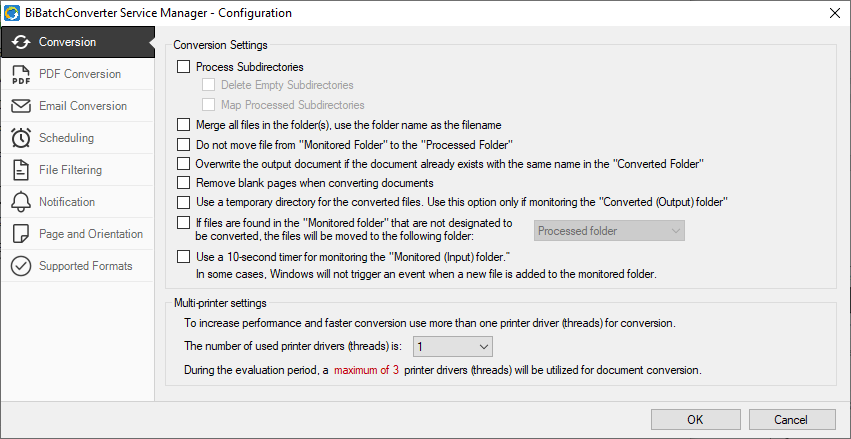
Conversion Settings covers options for configuring the BiBatchConverter Service, how to process the files and directories.

Process Subdirectories option converts the documents from the subdirectories of the monitored directories.
Delete Empty Subdirectories option deletes the empty subdirectories of the specified input directory.
Map Processed Subdirectories option mirrors the subdirectories and folder structure from the original monitored directories. This feature can be very useful if the user has several subdirectories and categorized, structured folders. If the Map processed subdirectories option is disabled, BiBatchConverter converts all the documents without directories into the Output directory.
If the Merge all files in the folder(s), use the folder name as the filename option is enabled, files in the monitored directory will be merged, and the filename of the merged output file will be the name of the folder.
For example, if the folder name is “C:\Monitored\John-Doe\ Case# 50-2023-DR-001805-XXXX-SB” the output file name will be “Case# 50-2023-DR-001805-XXXX-SB.PDF” if one is converting to PDF or “Case# 50-2023-DR-001805-XXXX-SB.tif” if one is converting to TIFF.
If the file already exists in the output folder, the BiBatchConverter Service will append the converted files to the existing document. If the output file does not exist, the BiBatchConverter Service will create the file automatically.
Do not move file from “Monitored Folder” to the “Processed folder” (Delete files after conversion) option deletes the converted documents from the source directory, once the document is converted successfully.
Overwrite output document if the document already exists with the same name in the “Converted Folder” option overwrites the documents in the converted directory, if already exists with the same name.
If the Remove blank pages when converting documents option is enabled, the BiBatchConverter Service will remove blank pages from the converted document.
If the document that is converted is a single blank page, there will be no output file generated by the BiBatchConverter Service.
Use a temporary directory for the converted files option moves the input document under conversion to the temporary directory, and once the conversion is finished, moves the document to the destination location (Processed directory). This option helps users to track the successfully converted documents, excluding the documents under conversion.
The If files are found in the "Monitored folder" that are not designated to be converted, the files will be moved to the following folder: option moves unprocessed files to the folder selected in the dropdown menu next to the option.
Use a 10-second timer for monitoring the Monitored (Input) folder option can be useful in cases when a network scanning device places files in a folder, and the Windows Operating System file monitoring will not trigger an event when the new file is added. In this case, the timer can be used to periodically check the folder for new files.
Configuring the number of CPU cores for document conversion
BiBatchConverter licenses can be purchased for a specific number of printers (number of used CPU cores). Multiple printers can process more documents simultaneously, resulting in faster document conversion. To read more about how to add more printer drivers to the BiBatchConverter Service, please refer to the Adding printer drivers to BiBatchConverter Service section of the manual.
NOTE: If your system has only 4 CPU Cores, we recommend no more than 3 Cores. A good rule on the number of CPU Cores is to have at least one more core as the number of documents to be processed in parallel.
To set up how many cores to use for document conversion, please select the desired number of CPU cores from the "The number of used printer drivers (threads) is:" dropdown list. During the evaluation period, a maximum number of 3 CPU cores will be utilized.

For more information, please refer to the following sections:
How to monitor multiple directories
Set up profile-based conversion